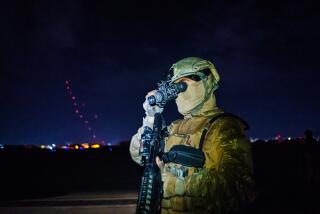Scud Pieces In, but Camels Out as War Trophies
- Share via
RIYADH AIR BASE, Saudi Arabia — Sgt. Clifton Carney swears it’s true.
An American officer, about to embark on his trip home after months in the Persian Gulf, wanted to take two camels with him, presumably as pets. “He wanted to take them back,” Carney said, shaking his head. “Can you believe that?”
The camel-toting officer was told he would have to leave the beasts behind.
Thousands of American military men and women who served in the Gulf are boarding planes and ships for home. And as they did after the Vietnam War and World War II, GIs are taking with them a colorful assortment of souvenirs.
It is up to Carney and his agents, in many cases, to stop them. Carney is the senior military customs inspector at the Riyadh Air Base. Here and at bases and ports throughout Saudi Arabia, a team of inspectors enforces a long list of taboo items.
Before their luggage is searched, departing troops are given one last chance to discard verboten booty in an “amnesty box” placed at all military terminals. Then, inspectors give the luggage a thorough going-over, one of the last steps in the bureaucratic maze that soldiers pass through as they leave the Gulf.
Most common among the trinkets that American GIs are packing are the so-called war trophies. Some, such as Iraqi helmets and fragments of exploded Scud missiles, are permitted. Others, such as Iraqi guns, ammunition and bayonets, are not.
Carney says he once confiscated an AK-47 assault rifle from a soldier’s luggage. Another GI had packed a land mine--with tragic consequences: It exploded, taking off the man’s leg and injuring two other people, Carney says.
Also on the banned war trophy list is a category called “human or animal body parts.” Carney says he has not discovered any in this category. In Vietnam, there were stories of American soldiers who collected enemy ears or fingers, but there was no evidence that it was a common practice.
Aside from camels, other animals have been carted along by soldiers, then confiscated. One man brought a cat, another officer a sea urchin.
Sand is another hot item that gets the cold shoulder from customs officials. Fearful of microscopic organisms that carry plant and animal diseases unknown on the North American continent, the U.S. Department of Agriculture has restricted the entry of sand into U.S. territory. Equipment, boots and uniforms have to be washed thoroughly.
The top American commander, Gen. H. Norman Schwarzkopf, probably raised a few inspectors’ eyebrows when he ceremoniously collected a sample of sand from a Kuwait beach to celebrate the liberation of that country.
Beach sand, because of its high salt content, is less offensive to Agriculture officials, and the general may have received special dispensation.
Like the United States and its allies did, President Saddam Hussein of Iraq scattered propaganda leaflets over the desert battlefield during the Gulf War. Some of these leaflets, which bore drawings of U.S. warplanes bombing children, are now showing up in American troops’ duffel bags, Carney said. They are promptly confiscated under the ban on “treasonable literature.”
The collection of war mementos is as old as war itself. In Vietnam, Americans collected North Vietnamese flags, insignia and web belts; during World War II, German helmets were popular.
Today, however, the rules governing what can and cannot be taken back are more stringent, according to a spokesman for the U.S. Central Command. Federal laws and safety concerns have led to more restrictions than in the past.
Vietnam combatants, for example, were allowed to keep non-U.S., non-automatic weapons; Persian Gulf veterans will have to content themselves with spent shells.
For souvenirs, no one does it better than the British.
Eight soldiers from the 14-20th King’s Hussars Cavalry Regiment are driving four bullet-riddled Iraqi Land Rovers home to England from Saudi Arabia.
“It’s quite nicely shot up,” Capt. Henry Joynson said recently as he admired one of the vehicles shortly before taking off on the 5-week, 9-nation drive.
The cavalrymen painted the Land Rovers white to make them look less military and less Iraqi, draped a Union Jack from one of the antennas and patched up some of the bullet and cluster-bomb holes in the sides of the vehicles.
They also had to do a bit of tinkering with the engines. Not only had some of the Land Rovers been booby-trapped, the wires under the hoods had been yanked out in an apparent effort by fleeing Iraqis to disable the cars.
Once the young Britons reach London, however, they will not be allowed to keep their prizes, according to a spokesman for the Defense Ministry. The Land Rovers will most likely end up in a museum.
More to Read
Sign up for Essential California
The most important California stories and recommendations in your inbox every morning.
You may occasionally receive promotional content from the Los Angeles Times.














